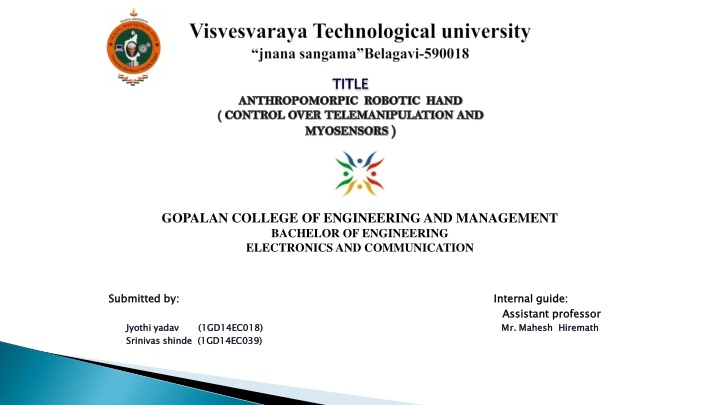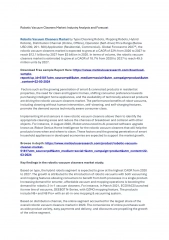Anthropomorphic Robotic Hand: Telemanipulation and Myosensors Control
This project at Gopalan College of Engineering and Management focuses on the design and fabrication of a humanoid robotic hand with multiple control signals, including finger angle, actuation, touch, force feedback, and telemanipulation using a sensor glove. The mechanical aspect involves mechanizing the complex movements of a human hand, utilizing high-torque linear muscle mechanics and an industrial-grade geared motor. Additionally, 3D designing and printing techniques are employed for creating intricate components.
Download Presentation

Please find below an Image/Link to download the presentation.
The content on the website is provided AS IS for your information and personal use only. It may not be sold, licensed, or shared on other websites without obtaining consent from the author.If you encounter any issues during the download, it is possible that the publisher has removed the file from their server.
You are allowed to download the files provided on this website for personal or commercial use, subject to the condition that they are used lawfully. All files are the property of their respective owners.
The content on the website is provided AS IS for your information and personal use only. It may not be sold, licensed, or shared on other websites without obtaining consent from the author.
E N D
Presentation Transcript
TITLE TITLE ANTHROPOMORPIC ROBOTIC HAND ( CONTROL OVER TELEMANIPULATION AND MYOSENSORS ) GOPALAN COLLEGE OF ENGINEERING AND MANAGEMENT BACHELOR OF ENGINEERING ELECTRONICS AND COMMUNICATION Submitted by: Internal guide: Assistant professor Jyothi yadav (1GD14EC018) M Srinivas Submitted by: Internal guide: Assistant professor r. Mahesh Hiremath Jyothi yadav (1GD14EC018) Mr. Mahesh Srinivas shinde Hiremath shinde (1GD14EC039) (1GD14EC039)
ANTHROPOMORPIC ROBOTIC HAND ( CONTROL OVER TELEMANIPULATION AND MYOSENSORS )
Overview of the project Overview of the project Mechanical design and fabrication of humanoid robotic hand with multiple control Finger angel signals Actuation signal Microcontroller -ATmega328 Touch signal Force feedback ( tactile sensor signal) Telemanipulation using sensor glove
Mechanizing the bio movement Mechanizing the bio movement The human hand has 5 complex fingers With 3 independent joints for each finger 15 joints require 30 linear actuators with additional 10 for side flex Human palm is approx 9x9 cm LA2 LA1
High torque linear muscle mechanics using TSA principal High torque linear muscle mechanics using TSA principal (Twisted string actuation) (Twisted string actuation) TSA is a mechanical process in which a group of parallel fiber strands Of same length are helically wound in order to decrease the over all axial length
Industrial grade high torque geared motor Industrial grade high torque geared motor The gear motor has a cross section of 10 x 12mm 12v high power carbon brushes gear ratio 298:1 speed 100rpm Torque 70 12v high power carbon brushes 298:1 100rpm 70 N.m N.m High torque Low rpm Low torque High rpm
3D designing and 3D printing 3D designing and 3D printing Complex small parts are designed using 123D Autodesk open source free software Conversion of the 3D model into 3D printable files and printing them using 3D printers for more robust and fine quality
Position sensor Position sensor As their name implies, Position Sensors they are referenced either to or from some fixed point or position. These types of sensors provide a positional feedback. Position Sensors detect the position of something which means that The most commonly used of all the Position Sensors , is the potentiometer because it is an inexpensive and easy to use position sensor. Dc gear motor with TSA Finger actuation microcontroler Feedback using PS
Precision rotary position sensor design and fabrication Commercially available Position encoders are placed at the back of the motor that provides closed loop feed back by tracking the speed of motor shaft The most commonly used of all the Position Sensors , is the potentiometer because it is an inexpensive and easy to use position sensor.
The limited size problem The limited size problem Average human hand has a dimension of about 94 x 84 mm How to properly use the limited size of the hand was one of our major issue Even though our linear actuator design were compact and very efficient with high torque its impossible to place and actuate 30 32 linear actuator in 94x84 mm space
The link and drive mechanism The link and drive mechanism Here one end of the link is connected to the knuckle And the other end to pip joint This simple link mechanism eliminates the use of 1 linear actuators per finger
Spring return mechanism Spring return mechanism One end of the retracting spring is anchored into the spring housing . The other end of spring is connected to the nylon string the other end of the sting is then connected to the knuckle This simple but very effective mechanism further eliminates the use of 2 linear actuators Extension springs Higher tensile strength strings are used for twisted string actuation and also the spring mechanism
Finger cross Finger cross- -sectional design sectional design Extension springs Silicon skin Ball bearings --6x13x5 Gear motor --300 :1
PROTOTYPE V1 PROTOTYPE V1 Redesigned finger mechanism for more compact and high mobility Highly sensitive and compliant with force feedback Stable with no backlash
EXPLODED FRONT VIEW EXPLODED FRONT VIEW M2 screws Position sensor linkage Ballbearing
TENDONS CABEL sleeve DC GEARED MOTOR
Motor driver L298N Motor driver L298N Dual full-bridge driver Integrated monolithic circuit with 15 pin config Power supply 5v 46v , 2A Integrated filter circuit and diodes to prevent back EMF
ATmega328 ATmega328 Architecture : AVR Operating voltage : 5V Flash Memory : 32kb Clock speed : 16Mhz Analog in pins : 8 Digital i/o pins : 22
Bluetooth Bluetooth interface HC interface HC- -05 05 Frequency : 2.4GHz Modulation : GSFK (Gaussian frequency shift keying) Emission power : 4db , class2 Security : Authentication and encryption HC-05 module is an easy to use Bluetooth SPP (Serial Port Protocol) module, designed for transparent wireless serial connection setup. UART interface with programmable baud rate Power supply : +3.3vDC 50mA With integrated antenna
Closed loop control with feedback Closed loop control with feedback B B L L U U E E T T O O O O T T H H 10k pot D2 D3 D5 M1 M2 PWM GND 5V a0 VCC GND RX TX Atmega 328 Dc motor 12v HC-05 Motor driver L298n Power supply 12v
START ALGORITHM FOR CLOSED CONTROL LOOP ALGORITHM FOR CLOSED CONTROL LOOP SET-UP I/O LOOP GET WANTED POSITION GET CURRENT POSITION CALCULATE GAP CALCULATE SPEED RUN CW YES IF CA < WA NO RUN CCW YES IF CA >WA NO STOP
ALGORITHM TO :: GET CURRENT POSITION ALGORITHM TO :: GET CURRENT POSITION ALGORITHM TO :: GET WANTED POSITION ALGORITHM TO :: GET WANTED POSITION START START ANALOG READ ANALOG READ MAP(523,1023,0,90) MAP(VAL,523,1023,0,90) CONSTRAIN (543,1000,0,90) RETURN VAL RETURN CONST STOP STOP
Existing data glove Existing data glove The Flex Sensor patented technology is based on resistive carbon elements.
DATAGLOVE SENSOR MODUAL DESIGN DATAGLOVE SENSOR MODUAL DESIGN LEFT SIDE VIEW RIGHT SIDE VIEW
Block diagram for data glove Block diagram for data glove Position sensor B B L L U U E E T T O O O O T T H H VCC GND RX TX Position sensor AT mega 328 Position sensor
Application of data glove Application of data glove Automotive controls Medical devices Industrial controls Computer peripherals Fitness products Musical instruments Measuring devices Virtual reality games Consumer products Physical therapy
CONCLUSIONS This paper presents a design and actuation system for a prosthetic hand. The actuation structure was shown to effectively execute grip configurations similar to those found in the three primary grips of the human hand (power, pinch, and lateral). The design also showed the ability of an underactuated and nearly fully actuated kinematic structure to exist in a single actuation system using remarkably different types of actuators, without compromising the required size and weight of the prosthetic hand.
REFERENCES REFERENCES [1] Bicchi, A., 2000, Hands for dexterous manipulation and robust grasping: a difficult road toward simplicity , IEEE Transactions on Robotics and Automation, 16(6):652-662. [2] Foegelle, M., Li, K., Pavacic, A., Moller, P., Test & Measurement: Developing a Standard Hand Phantom for Wireless Testing, [Online]. Available: http://www.wirelessdesignmag.com/ShowPR.aspx?PUBCODE=055& ACCT=0029956&ISSUE=0811&RELTYPE=tm&PRODCODE=W02 60&PRODLETT=A&CommonCount=0, [3] Norkin, C., Levangie, P., 1992, Joint Structure & Function: A Comprehensive Analysis: Second Edition, F. A. Davis Publications, 262-299. [4] Nelson, D. L. Tendon Laceration Page, [Online]. Available: http://www.davidlnelson.md/Tendon_laceration.htm, [5] Valero-Cuevas, F. J., Towles, J. D., Hentz, V. R., Quantification of fingertip force reduction in the forefinger following simulated paralysis of extensor and intrinsic muscles, Journal of Biomechanics 33 (2000) 1601-1609. [6] Kevin G. Keenan, K. G., Veronica J. Santos, V. J., Venkadesan, M. and Valero-Cuevas, F.J., Maximal Voluntary Fingertip Force Production Is Not Limited by Movement Speed in Combined Motion and Force Tasks, The Journal of Neuroscience, July 8, 2009 29(27):8784 8789. [


![❤[READ]❤ Robotic Exploration of the Solar System: Part I: The Golden Age 1957-19](/thumb/21623/read-robotic-exploration-of-the-solar-system-part-i-the-golden-age-1957-19.jpg)




















